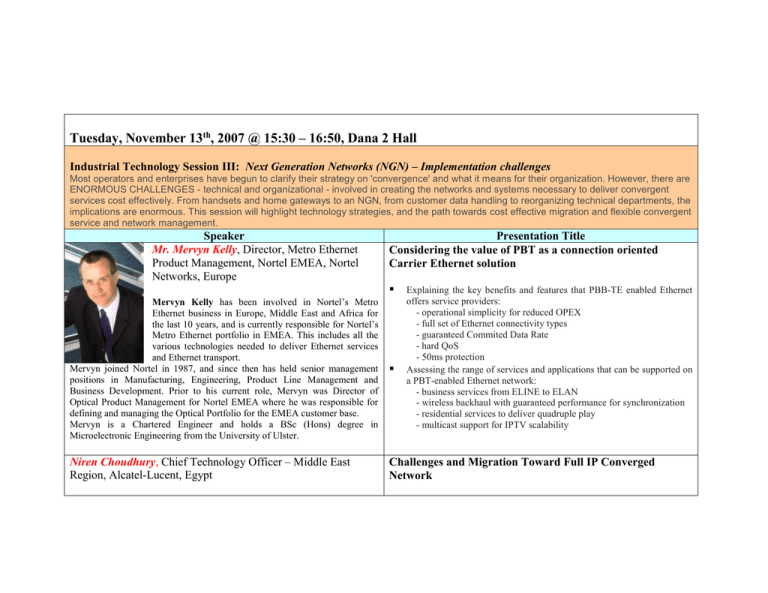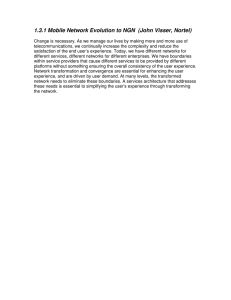Tuesday, November 13 Next Generation Networks (NGN) – Implementation challenges
advertisement

Tuesday, November 13th, 2007 @ 15:30 – 16:50, Dana 2 Hall Industrial Technology Session III: Next Generation Networks (NGN) – Implementation challenges Most operators and enterprises have begun to clarify their strategy on 'convergence' and what it means for their organization. However, there are ENORMOUS CHALLENGES - technical and organizational - involved in creating the networks and systems necessary to deliver convergent services cost effectively. From handsets and home gateways to an NGN, from customer data handling to reorganizing technical departments, the implications are enormous. This session will highlight technology strategies, and the path towards cost effective migration and flexible convergent service and network management. Speaker Mr. Mervyn Kelly, Director, Metro Ethernet Product Management, Nortel EMEA, Nortel Networks, Europe Presentation Title Considering the value of PBT as a connection oriented Carrier Ethernet solution Explaining the key benefits and features that PBB-TE enabled Ethernet offers service providers: - operational simplicity for reduced OPEX - full set of Ethernet connectivity types - guaranteed Commited Data Rate - hard QoS - 50ms protection Assessing the range of services and applications that can be supported on a PBT-enabled Ethernet network: - business services from ELINE to ELAN - wireless backhaul with guaranteed performance for synchronization - residential services to deliver quadruple play - multicast support for IPTV scalability Mervyn Kelly has been involved in Nortel’s Metro Ethernet business in Europe, Middle East and Africa for the last 10 years, and is currently responsible for Nortel’s Metro Ethernet portfolio in EMEA. This includes all the various technologies needed to deliver Ethernet services and Ethernet transport. Mervyn joined Nortel in 1987, and since then has held senior management positions in Manufacturing, Engineering, Product Line Management and Business Development. Prior to his current role, Mervyn was Director of Optical Product Management for Nortel EMEA where he was responsible for defining and managing the Optical Portfolio for the EMEA customer base. Mervyn is a Chartered Engineer and holds a BSc (Hons) degree in Microelectronic Engineering from the University of Ulster. Niren Choudhury, Chief Technology Officer – Middle East Region, Alcatel-Lucent, Egypt Challenges and Migration Toward Full IP Converged Network Niren Choudhury is a CTO for Middle East Region in Alcatel-Lucent located in Cairo, Egypt. He has been with Alcatel –Lucent (AT&T, Lucent - Philips JV, Lucent, Alcatel-Lucent) for 23 years in various capacity after joining AT&T in 1985. Prior to his current assignment, Niren was in Bell Laboratories, headed Lucent Reliability Program and served as Senior Director for Design & Engineering in China & Asia Pacific region located in Shanghai, China. Niren also represented AT&T and Lucent in various Industry Standard Organizations along with representing AT&T in Joint Partnership Program with HP and Ford. After completion of his B.Sc (Engineering), Niren also served five years in India in design and installation of Transmission Line Network prior to emigrating to US in 1983 for his Masters Degree in Electrical Engineering from Ohio University. He has completed his Ph.D course work from Rutgers University. He also maintained ASQC’s Quality and Reliability Certifications. Niren’s expertise includes Telecom Network Architectures, Product/Systems Reliability modeling and wide ranges of Telecom Products and Applications knowledge from Submarine Cables to Consumer products. Frank Tuhus, Senior Systems Engineer, Cisco Systems, Norway 7 Years with Cisco First 6 years working with Service Providers in the Nordics especially in Norway. He has been working with Voice, Mobile and NGN for several years and are currently based in Saudi Working with the Mobile operators there. He was a part of the team that designed and implemented the first VoiP service in Norwegian Service Provider in 2003 and have since delivered many such services. As the communication industry is itself in state of transformation, it is becoming increasingly important to critically analyze the challenges and benefits before any provider decides upon the IP transformation. The ultimate objective is how to implement the most cost effective transformation that will provide sustainable profitability and value to everyone. Challenges are to provide broadband access for the end to end triple/quadruple play application, multi service IP/MPLS and carrier Ethernet routers in both enterprise and residential segments within various constraints cost effectively. Considering that what we are seeing now and will be seeing in near future is just the beginning, in this paper, effort will be taken to review key variables that will influence the positive outcome of the complete IP Transformation. Successful transformation will require clear vision and strategy and commitment to follow through. Knowing customer and market well is essential to convert market information to a dynamic business case. Selecting strategic partners with similar vision and value chain to overcome challenges and rewards together will certainly enhance the possibility of success. The network design will be equally critical to build the network on a scalable architecture based on the existing network so that transformation will bring the benefits over long term to everyone in customer-supply chain. IP NGN The Cisco IP Next-Generation Network (IP NGN) vision and architecture address the sweeping transformation of a service provider’s and large Enterprise entire network and business. It is designed to help our customers develop and plan their organizations, network architectures, and business models for the future to deliver a sustainable competitive advantage.


